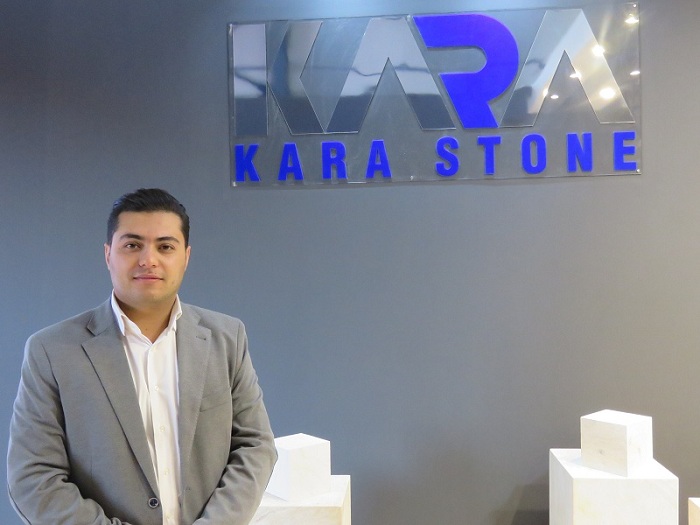Stone Industry Problems According to Hojat Pourhasani

CEO of Kara Collection: High VAT, high cost of stone production, lack of quality upgrades to world standards by stone craftsmen for reasons such as failure to obtain low interest rate banking facilities, failure to split tax rates and so on. Government support programs to increase the capacity of knowledge and raise the quality and competitiveness of the world in the process of processing and commerce are among the problems faced by industrial activists and domestic producers.
According to Iran's International Stone Exhibition, Hojat Pourhassani, CEO of Kara Collection, interviewed Stone World Magazine, which reads as follows:
Reasons for the success of a business
I believe that at first the worldview and understanding of the responsible person, the passion, the individual motivations and the love for work are the key elements of a business unit's success. To be clear, utilizing long-term planning, organizational targeting, and focus on achieving it through strategy and execution practices, organizational persistence and persistence in doing things like delivering quality products and services, and having creative and welcoming ideas. And supporting the ideas and ideas of creative people, as well as making the right use of experts and experts for the purposes of the organization, updating hardware and software, synchronizing the organization with international standards in all sectors, adhering to the conditions Supply and demand in international markets and ultimately create a lucrative brand including Import a commercial production unit will lead to success.
Diversity of Iranian rocks in the first place
The world's ornamental stone reserves, including granites, marbles, travertines, and marbles, amount to about fifty-one billion tons, with Iran's top color and quality variety of stones being the world's top. Iran ranks fourth in the world in terms of decorative stone reserves and in the list of top seven countries in the production of decorative stones. According to statistics, forty-one percent of the country's total employment is in ornamental stone mines, with an estimated one million people employed directly or indirectly in the country's ore mining sector. About 400,000 can work in ornamental stone. . Given such statistics and the high capacity of mines, it may be time to consider how to best utilize and enhance our assets. Of course, in the last few years, the authorities' attention to replacing unstable oil revenues with mining revenues is a promising prospect, and we hope that the stone industry in the country will achieve its true status and status by planning and supporting officials. At that time, it will no doubt be a powerful pillar for the country's national economy.
Major problems of Iranian stone industry
I summarize the major problems of the Iranian stone industry in several key areas (mines, processing and commerce): high VAT, high cost of stone production, lack of quality upgrading of products to world standards by stone craftsmen, such as lack of Receiving low-interest rate banking facilities, non-division of taxation conditions, etc. Finally, the lack of attention by government support programs to increase knowledge capacity and raise the quality and competitiveness of the world in the process of processing and commerce etc. Industrial activists and domestic producers.
Providing facilities to experienced and experienced people in the industry
Facilities are currently being provided, but the government and banking system must improve research and quality oversight of the facilities. These facilities should be made available to experienced and experienced people in the industry. We have seen many people over the years who, with no business experience or experience, have received bank facilities and set up their own mines and factories, and after a short time with bankruptcy, closed their business. have became. I believe it is a flaw in the regulatory and audit system.
We have to standardize
Indicators of quality improvement of production and main strategy in supporting the production and industry cycle in the country in three sectors: mining, processing and commerce, standardization in line with the world industry leaders and creating competitive power through proper management, design and standardization. Systematic processes with regard to long-term organization plans, review and allocation of resources, personnel and executive and support teams, special attention to customers and understanding of the market, environmental and community issues, analysis of reports and performance results, and ultimately changes and Reforms. Research and development in the mentioned sectors are among the important indicators of production promotion that should be taken into consideration.
Import of stone crop to be done
I think the import of stone into the country can be useful and this is part of the concept of a global market, but this should be done through government oversight, scrutiny and planning, given the current conditions of entry of some Imported stones will cause serious damage to the body of the country's stone industry. For example, Turkish lettuce, which we have similar in Iran, or Turkish grade travertine, which is also less expensive than our third grade travertine, which is not recommended for import. But some other stones in the domestic market are diversifying and complementing the basket of decorative stones, in which cases, instead of importing slabs, Kop can be imported to Iran so that other craftsmen with the support of the government can increase the quality of their products. To find.
Importing stone carp is in favor of factory owners
I believe that importing stone as a slab is better than slabs. Because the manufacturing process has been done in our own stone mills and this process creates employment, turnover and the improvement and standardization of industrial units. Coop imports should be carefully planned with respect to domestic and international reserves and when supplies are made that we do not have a sample of that stone in Iran.










